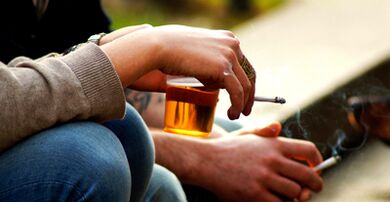According to many experts, chronic prostatitis is an inflammatory disease caused by an infection with the possible increase in autoimmune disorders, characterized by damage to the parenchymal and interstitial tissue of the organ.The disease has been known for medicine since 1850, but still today it remains poorly understood and difficult to treat.Chronic bacterial prostatitis (6 - 10%) and non -bacterial (80 - 90%) are the most common and social inflammatory diseases in men, significantly reducing the quality of their lives.The disease is mainly recorded in young and middle -aged people and is often complicated by disorders of copulative and generating functions (decrease in power, infertility, etc.).The disease is recorded in men in 8 - 35% of cases aged 20 to 40 years.
The cause of bacterial prostatitis is pyogenic flora that penetrates the gland from the urethra, or through the lymphogenic and hematogenous pathways.The etiology of chronic nonbacterial prostatitis and its pathogenesis remains unknown.It mainly affects men over 50 years of age.
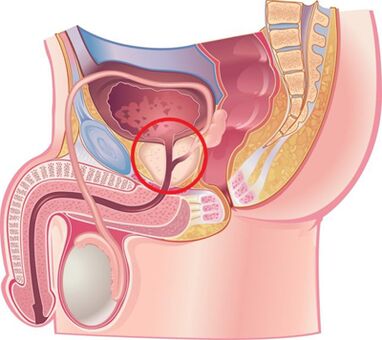
Reasons for developing the disease
Chronic prostatitis is currently considered a poletiological disease.There is an opinion that the disease occurs as a result of the infection that enters the prostate, and then the pathological process continues without its participation.This is facilitated by a number of non -infectious factors.
Infectious factors in the development of chronic prostatitis
In 90% of cases, pathogens enter the gland from the urethra, resulting in acute or chronic prostatitis.There have been cases of asymptomatic cart.The course of the disease is influenced by the state of protection of the human body and the biological properties of the pathogen.It is assumed that the transition from acute prostatitis to chronic occurs due to loss of tissue elasticity due to excess production of fibrous tissue.
The following pathogens are found among the causal agents of chronic prostatitis:
- In 90% of cases, the disease detects gram -negative bacteria such as Escherichia coli (Escherichia coli), Enterococcus faecalis (fecal enterococcus), and somewhat rarely - pseudomonas aeruginosa, klebsiella s., Proteus spp.Gram-positive enterococcal, streptococcal and staphylococcal bacteria are rare.
- The role of coagulase-negative staphylococci, Ureaplasma, Chlamydia, Trichomonas, Gardnella, anaerobic bacteria and Candida genus fungi have not been fully clarified.
The infection enters the prostate in several ways:
- The adhesive route is more likely, as evidenced by the frequent combination of prostate and urethritis.
- Hematogenous prostate develops when the infection penetrates the gland through the bloodstream, which is observed in chronic tonsillitis, sinusitis, periodontitis, pneumonia, cholecystitis and cholangitis, purulent skin diseases, etc.
- Chronic prostatitis contact develops with urethritis and strict urethra, when the infection penetrates the gland that adheres to the urine, with purulent adrenal infections, canalicular from epipiditis, deficit and funicular, during urological diagnostic and therapeutic manipulations (catheterization).
- Lymphogenically infection penetrates the prostate with processes, thrombophlebitis of hemorrhoids, etc.

Factors Non -Infectant in the development of chronic prostatitis
Chemical
According to experts, the main role in the development of chronic prostatitis belongs to the urine of intrapostatic reflux when the urine is throwing from the urethra to the iron, which leads to a violation of the emptying of the prostate vesicles and seminals.
With the disease, vascular reactions develop in organ edema, nervous adjustment and mood of tone tissue of smooth urethra muscle, and activation of alpha are disturbed1- Adrenoreceptors cause the development of dynamic barriers and contribute to the development of new intrapostatic refluxes.
Congratulations involved in the urine, with reflux, lead to the development of a "chemical inflammatory response".
Hemodynamic disorders
Support chronic inflammation of the circulatory disorders in the pelvic organs and scrotum.The station takes place in persons leading a sedentary lifestyle, for example, for drivers, office employees, etc.Maintaining the inflammatory process, taking spicy and spicy foods, alcohol and smoking, etc.
Other factors
There are many other factors that support the chronic inflammatory process in the prostate.These include:
- Hormonal.
- Biochemical.
- Violations of immune response.
- Autoimmune mechanisms.
- Infectious and allergic processes.
- Characteristics of the structure of the prostate glands, leading to the difficulty of complete drainage.
Very often, it is not possible to determine the causes of chronic prostatitis.
Prostatitis Classification
According to the classification proposed in 1995 by the National Institute of Health of the United States, the prostate is divided into:
- Sharp (category I).It is 5 - 10%.
- Chronic bacterial (category II).It is 6 - 10%.
- Chronic non -bacterial inflammatory (Category IIIA).It is 80 - 90%.
- Chronic non -bacterial non -inflammatory (category IIIB) or chronic pelvic syndrome.
- Chronic prostatitis detected by the accident (category IV).
Signs and symptoms of chronic prostatitis
The course of chronic prostatitis is long, but not monotonous.The periods of irritation are replaced with periods of relative drowsiness that occur after comprehensive anti -inflammatory and antibacterial therapy.
The development of chronic bacterial prostatitis is often preceded by the urethritis of the bacterial or gonorrhea nature, circulatory disorders in the pelvic organs and scrotum (hemorrhoids, varicocells, etc.), sexual surplus.
Patients with chronic prostate present many complaints.They have been treating doctors for years, but are rarely examined for a prostate disease.About a quarter of patients present no complaints, or the disease persists with few clinical symptoms.
Patient complaints with chronic prostate can be conditionally divided into several groups.
Urmination of urination associated with narrowing of the urethra:
- Difficulties at the beginning of urination.
- A poor flow of urine.
- With interruption or urination ra.
- A feeling of incomplete bladder emptying.
Symptoms caused by irritation of nerve endings:
- Frequent urination.
- Calls for urination are sharp and strong.
- Urination in small parts.
- Urine incompetence while encouraging to urinate.
Pain syndrome:
- The intensity and nature of the pain are different.
- Pain localization: lower abdomen, area of perineum, rectum, groin and lower back, inner surface of the buttocks.
Sexual function disorders:
- Pain in the rectum and in the urethra during spilling.
- Slow up.
- Loss of orgasm.
- Premature spill, etc.
From the nervous system: neurotic disorders in the form of regulation of patients' attention in their state of health.
Signs and symptoms of chronic non -bacterial prostatitis
Chronic pelvic pains in men (CFTB) continue with common symptoms for chronic prostatitis, but in the 3rd part of the urine and a secret of the prostate in the study of bacteria are missing.Simulation of CTB can simulate chronic nebacterial interstitial cystitis, rectal diseases, spastic pelvic spastic myalgia, and a functional prostate caused by the intrigue of damaged organic organs and its hemodynamics.
In the event of a damaged neurovegetative function, there is an aton and impaired intrigue of the gland, which is manifested by the difficulties of rapid and complete closure of the urethra lumen.At the same time, urine, after urination, continues to emerge for a long time.In such patients, in the study, instability and increased irritability are found, which is manifested by increased sweating and irritability of cardiac activity, changes in dermography.
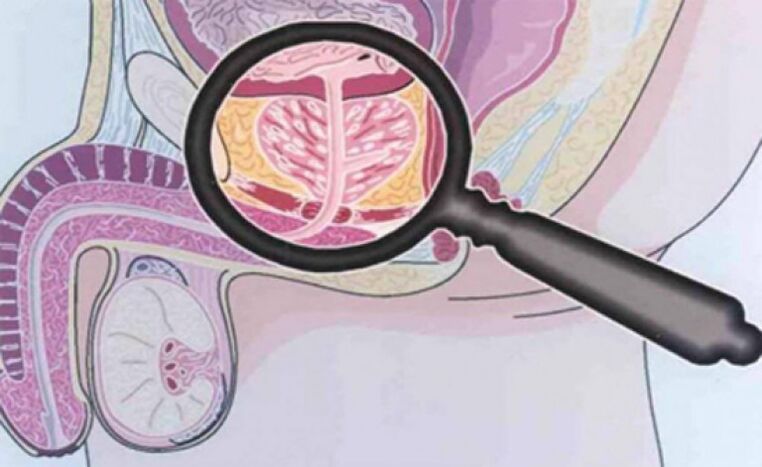
Complications of the disease
The long course of chronic prostatitis is complicated by disorders of sexual and reproductive functions, the development of diseases such as vesiculitis and epipidymite, as well as strengthening the organ.Organ sclerosis exacerbates local microcirculation and urodynamics, as well as the results of surgical interventions.Periurethral tissue fibrosis leads to the development of urination disorders.
Troubleshooting
Due to the fact that there are many reasons for the development of chronic prostate, a whole range of diagnostic tests is used to diagnose it.The success of treatment depends on the correct identification of the causes of the disease.The diagnosis of chronic prostatitis is based on the following data:
- Classic triads of symptoms.
- Complex of physical methods (digital rectal prostate examination).
- A set of laboratory methods (urinary and microscopy of prostate secretions, culture and determination of microflora sensitivity to antibacterial drugs, general urine and blood analysis).
- To detect gonococci, bacterioscopy of a stain from the urethra, PCR and serological methods (for the detection of ureaplasma and chlamydia).
- Urofluometry.
- Prostate biopsy.
- A set of instrumental methods (ultrasound examination).
- Determination of the patient's immune status.
- Determination of neurological status.
- With the ineffectiveness of the treatment and doubt of developing complications, calculated and magnetic resonance imaging, blood planting, etc.
Prostate gland palpation
Prostate palpation, which increases during the period of irritation and decreases in the inflammatory process subsidiary, is of primary importance in diagnosing the disease.In chronic prostate, during the period of iron irritation is swollen and painful.
The density of the consistency of the organs can be different: the softening and compression areas are palpable, the western areas are defined.During palpation, it is possible to evaluate the shape of the gland, the condition of the seed tubercles and the surrounding tissue.
The process of transchectal finger examinations is combined with the confiscation of the gland.Sometimes there is a need to get a secret from each part separately.
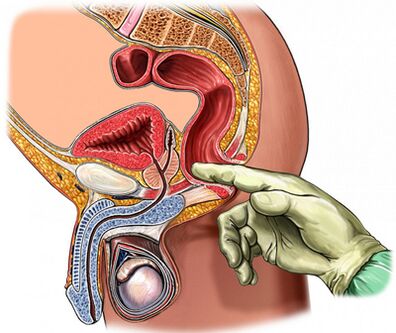
Analysis of 3 glass of urine and prostate secret
The golden standard in the diagnosis of chronic prostatitis are:
- Collection of the first part of urine.
- Collecting a second part of urine.
- Taking the secret of the gland from the massage.
- Collection of the third part of the urine.
Next, a microscopic and bacteriological examination of the material is performed.
With prostate inflammation:
- Microbial Number (CFU) exceeds 103/Ml (104/ml for epidermal staphylococcus), but you should not neglect the small number of germs, counting in tens and hundreds.
- The presence of 10-15 leukocytes in the field of vision, identified by microscopy, is a generally accepted criterion for the presence of an inflammatory process.
The secretion of the prostate and the 3rd part of the urine undergo microscopic and bacteriological examination:
- In chronic bacterial prostate, there is an increase in the number of leukocytes in the secretion of the gland and the third part after the urine massage, and the bacteria (mainly of the intestinal group).
- With non -bacterial prostatitis, there is an increase in the number of leukocytes in the secretion of the gland, but the microflora is not detected.
- In CPP, there is also no increased number of leukocytes and microflora.
Normal prostate secretion:
- Less than 10 leukocytes per view field.
- There is a large amount of lecithin grains.
- There are no microflora.
In chronic prostatitis, below is found in prostate secretion:
- The number of leukocytes is large - exceeds 10-15 in the field of viewing.
- The number of lecithin grains is reduced.
- The pH of secretion is moved to the alkaline side.
- The content of acid phosphatase is reduced.
- The activity of lysozyme has increased.
Getting negative results of prostate secretion once does not prove the lack of an inflammatory process.
The value of the prostate secretion crystallization test remains.Normally, during crystallization, a characteristic pattern is formed in the form of a fern leaf.In the event of a violation of the properties of prostate secretion accumulation, such a model is not formed, which occurs when the hormonal androgenous background changes.
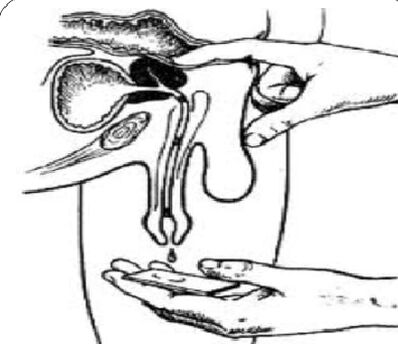
Ultrasound
If prostate disease is suspected, ultrasound examination of the gland (transchectal ultrasound), the kidneys and bladder is optimal, which allows us to determine:
- The volume and size of the gland.
- The presence of stones.
- Seminal vesicles sizes.
- The condition of the bladder walls.
- Quantity of remaining urine.
- Scrotum structures.
- Another type of pathology.
Other methods of prostate examination
- The condition of urodynamics (study of urine flow rate) is easily determined and simply using a study such as uroflowmetry.With the help of this study, it is possible to immediately detect signs of bladder exit barriers and perform dynamic monitoring.
- A puncture biopsy is performed if the abscess formation is suspected, benign hyperplasia and prostate cancer.
- To clarify the reasons for developing infrast barriers, X -ray and endoscopic examinations.
- In case of long -term inflammatory process, it is recommended to perform urethrocystoscopy.
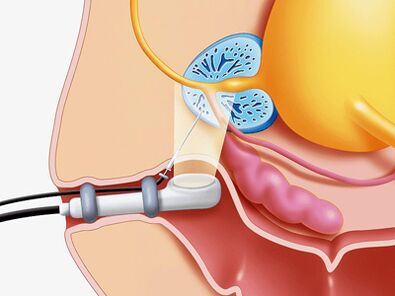
Diagnosis
Chronic prostatitis should be distinguished from vesiculoprostatostasis, vegetative prostatopathy, congestive prostatitis, pelvic floor myalgia, neuropsychiatric disorders, pseudodyysynergia, secret detrophy, sexual dystrophy, sexual dystrophy.Bladder neck hypertrophy, urethra coercion, tuberculosis, prostate and bladder cancer, urolithiasis, chronic epipidimitis, inguinal hernia.
Treatment of chronic prostatitis
Treatment of chronic prostatitis should begin with lifestyle changes and patient diet.
When treating the disease, medicines affecting different parts of the pathogenesis are used simultaneously.
Key therapy guidelines:
- Elimination of causal microorganisms.
- Anti-inflammatory therapy.
- Normalization of blood circulation in the prostate and pelvis organs.
- Normalization of adequate acin drainage of prostate.
- Normalization of the hormonal profile.
- Prevention of organ sclerosis.
For the treatment of chronic prostatitis, the following drug groups are used:
- Antibacterial.
- Anticolinergic.
- Vasodilators.
- Alpha1- adrenergic blockers.
- 5 alpha reductase inhibitors.
- Cytokine inhibitors.
- Non -steroidal anti -inflammatory.
- Angioprotectors.
- Immunomodulators.
- Preparations Affecting The Exchange of Urats.
Antibiotics in the Treatment of Bacterial Chronic Prostatitis
Antibacterial Therapy Should Be Carriated Out Taching Ino Account the sensitivity of detected microorganisms to antibiotics.In the case of non -detection of the pathogen, empirical antimicrobial treatment is used.
The Drugs of Choice Are Fluoroquinolones of the II - IV Generation.They quickly penetrate the glandular tissue with ordinary methods of use, show activity against a large group of gram -negative microorganisms, as well as ureaplasma and chlamydia.In Case of Failure of Antimicrobial Treatment, IT SHOULD BE ASSUMED:
- Microflora polyurezancy,
- Short (Less than 4 Weeks) Treatment Courses,
- Incorrect Selection of the Antibiotic and Its Dosage,
- Changes in the Type of Pathogen,
- The presence of bacteria that live in the ducts of the prostate, the cover with a protest extracellular membrane.
The Datation of Treatment Should Be At Least 4 Weeks With the Bond Bacteriological Control.In case of preservation in the 3rd portion of urine and the second of the prostate of Bacteriuria more than 103Correspondence of a Re -antibacterial Therapy for a period of 2 to 4 Weeks is prescribed.
Cytokine Inhibitors in the Treatment of Chronic Prostatitis
Cytokines are glycoproteins that are secreted by immune and other cells in conditions of inflammatory reaction and an Immune Response.They take an active part in the development of a chronic inflammatory process.
Nonsteroidal anti -inflammatory Drugs
Non -steroidal anti -inflammatory drugs have an anti -inflammatory effect, Reduce Pain and Fover.They are widly use in the treatment of chronic prostatitis in the form of tablets and suppositories.The most effective is the rectal path of Introduction.
Immunotherapy
In the Treatment of Bacterial Chronic Prostatitis, in Addition to Antibiotics and Anti -inflammatory Drugs, immunomodulating agents are used.The most effective is the rectal path of their introduction.The immunomodulator is widely used, which enhances functional phagocyte activity, which contributes to a more effective elimination of pathogens.
Alpha-Blockers in the Treatment of Chronic Prostatitis
It is proven that alpha-1 adrenergic shoes normalize the tone of the smooth muscle of the prostate part of the urethra, seed bubbles and prostate capsules, which makes the medicines of this group very effective in treating the disease.Alpha-1 adrenergic shoes are used in patents with pronounced urination disorders in the absence of an active inflammatory process.
With CTB, the Treatment period is from 1 to 6 months.
5A Reductase inhibitor in the treatment of abacterial prostatitis and CPP
It is proven that under the influence of the 5a-reductase enzyme, testosterone is transformed into a 5-dihydrotestosterone prostate form, whose activity in prostate cells is more than 5 times higher than testosterone activity, which in older people leads to an expansion of the organ due to epithelial components.
When taking a 5-reductase inhibitor, stromal tissue atrophy is observed for 3 months, glandular tissue atrophy for 6 months, secretory function is impeded, the severity of the pain and the volume of the gland decreases, the tension and swelling of the organ decrease.
The role of anti-sclerotic drugs in the treatment of chronic prostatitis
With long -term inflammation in the prostate gland, fibrosis develops, which is manifested by disturbances in microcirculation and urodynamic.Anti-sclerotic drugs are used to prevent the fibrosis process.
Other medicines used in the treatment of chronic prostatitis
Along with the drugs described above, below are used to treat the disease:
- Antihistamines.
- Vasodilators and angioprotectors.
- Immunosuppressants.
- Drugs that affect uratic metabolism and citric acid trisodium acid.
Plant products
Effective in the treatment of prostatitis, the use of medicine in the form of candles containing a complex of biologically active peptides from the cattle prostate gland.
Under the influence of the drug,:
- Stimulation of metabolic processes in the glandular tissue.
- Improving microcirulation.
- Reducing edema, leukocyte infiltration, stagnation and pain.
- Prevention of thrombosis in the venules of the prostate gland.
- Increased activity of the secretory epithelium of acinus.
- Improving sexual function (increased sexual desire, restoration of erectile function and normalization of spermatogenesis).
The massage of the finger of the prostate gland
A number of researchers say that in chronic prostatitis, a finger massage should be used, taking into account known contraindications.
Physiotherapy
The effectiveness of physiotherapeutic procedures in the treatment of prostatitis has not been proven today, the mechanism of action is not scientifically created, no side reactions have been studied.
Preventing chronic prostatitis
Starting preventing the development of chronic prostatitis, you should know:
- The risk of developing the disease increases over the years.
- Representatives of the Negroid race are more prone to the disease.
- A family predisposition to the disease is not excluded.
People with a predisposition to the development of chronic prostate should be more attentive to their state of health.
Disease Prevention Tips:
- Take a sufficient amount of fluid.Frequent urination promotes the flow microflora from the urethra.
- Prevent diarrhea and constipation.
- Adapted to a rational diet.Do not eat saturated foods with carbohydrates and saturated fats, which leads to an increase in body weight.
- It should be limited to the use of substances that irritate the urethra: sharp and spicy dishes, smoked meat, sauces and spices, coffee and alcohol.
- Refuse smoking.Nicotine adversely affects the condition of the vascular walls.
- Do not overcome it.
- Do not keep the bladder emptying.
- Run an active lifestyle, play sports.Do exercises to strengthen the pelvic muscles, which allows you to eliminate venous blood stagnation, which, in turn, supports the normal function of the prostate gland.
- Run regular sex life.Avoid prolonged abstinence.Iron must be released in a timely manner from the secret.
- Stay monogamous relationship worshipers.Illegal sexual intercourse increases the chance of having sexually transmitted diseases.
- If the complaints are filed by the genitourinary authorities, contact a urologist immediately.
